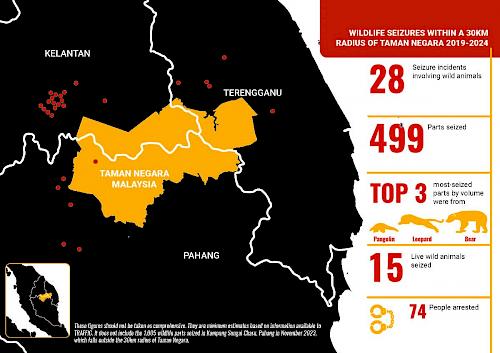Major Malaysian seizure and prosecution validates ramped up enforcement of protected area
A massive seizure of wildlife parts near a premier national park in Malaysia, and legal action against four people involved, is demonstrating the value of greater enforcement around the country’s biodiversity hotspots.
Over 1,000 wildlife parts from a long list of iconic and endangered species were seized in a house not far from the Taman Negara National Park last November.
In November shortly after the seizure, three Vietnamese nationals and one Malaysian were arrested. Two charges – for possession of snares and pangolin parts – were initially laid against them in court, under the Wildlife Conservation Act 2010.
But just last month, upon the completion of investigations and forensic testing, authorities brought an additional 13 charges against the four, attesting to the enormity of their operations.
Taman Negara’s 4,343 km² and the surrounding landscape are among the last remaining safe havens of the Critically Endangered Malayan tiger and a myriad of other species.
It has been the focus of increased patrolling and surveillance for poaching and illegal trade, especially through a joint enforcement taskforce, Ops Bersepadu Khazanah, since 2019.
 According to TRAFFIC data, there have been at least 28 known seizure incidents involving wild animals within a 30 km radius of Taman Negara in the past five years. These incidents have led to at least 74 arrests. Most recently a Vietnamese poacher caught inside the park with 54 leopard parts, weapons, and tools, was sentenced to six years in prison.
According to TRAFFIC data, there have been at least 28 known seizure incidents involving wild animals within a 30 km radius of Taman Negara in the past five years. These incidents have led to at least 74 arrests. Most recently a Vietnamese poacher caught inside the park with 54 leopard parts, weapons, and tools, was sentenced to six years in prison.
But the scale of the operation in the November seizure in Panching, Pahang made it a particularly shocking case – among the thousand parts seized were a staggering 397 bear claws.
There were also parts of leopard Panthera pardus, pangolin Manis javanica, tiger Panthera tigris, clouded leopard Neofelis nebulosa, serow Capricornis sumatraensis, Asian golden cat Catopuma temminckii, and elephant Elephas maximus confiscated.
Ten out of two dozen wildlife species seized are Totally Protected species, with seven falling under a specific section of the Act (Schedule 10), which carries some of the highest penalties and compulsory imprisonment for wildlife offences.
This was a group driving a significant loss and in an area with a big target on its back. The parts they had their hands on equalled dozens of leopards, bears and tigers. We hope to see strong prosecution outcomes to drive the message that this level of crime is not tolerated.”
Kanitha Krishnasamy, Director for TRAFFIC in Southeast Asia “This discovery and the disruption of this group would not have been possible without dedicated long term investment in investigations and inter-agency collaboration in this area. It’s imperative that resources continue to be invested to support efforts here,” she said.
Over the years heightened enforcement scrutiny around this national park have uncovered a persistent wildlife poaching and trafficking threat in the area.
On 25 June, enforcers from the same taskforce seized parts of a tiger from two locations in the town of Rompin. The town is also located in the state of Pahang which hosts part of the Taman Negara national park. The six suspects arrested in the case have claimed trial to one charge under the Wildlife Conservation Act 2010.





